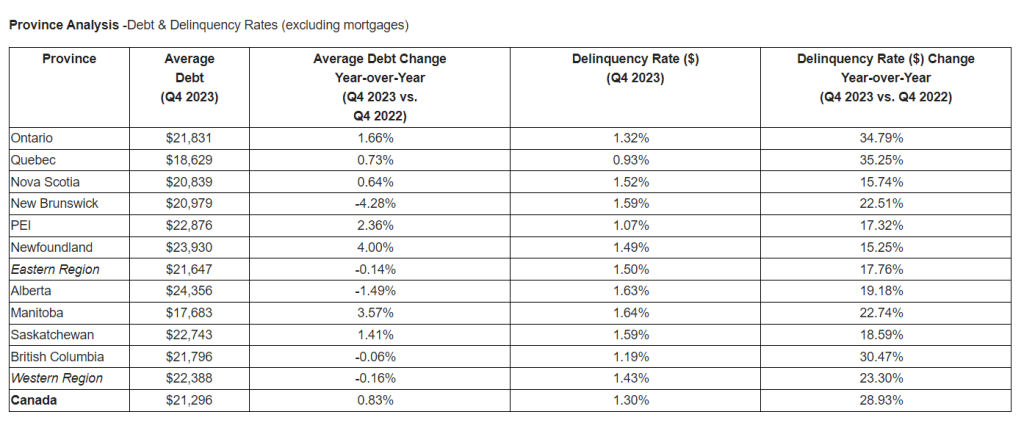
Toronto (Mar 5) – While all Canadians are feeling the pain of high interest rates, mortgage deliquencies have soared in Ontario and British Columbia according to a new report on credit trends in Canada.
The Equifax® Canada’s latest Market Pulse Consumer Credit Trends and Insights report finds that economic pressure is more visible as many consumers struggle to make monthly credit payments. Delinquency rates for non-mortgage balances that are 90+ days overdue went up from one per cent in Q4 2022 to 1.3 per cent in Q4 2023, representing a 28.9 per cent increase. Mortgage delinquency rates over the last 12 months saw a 52.3 per cent increase, from 0.09 per cent to 0.14 per cent.
The report says that Ontario and British Columbia have been particularly affected, with mortgage delinquency rates soaring by 135.2 per cent and 62.2 per cent respectively compared to Q4 2022, surpassing pre-pandemic levels. Financially stressed mortgage holders in these provinces are also increasingly missing payments on their credit cards. Missed payment levels in Ontario and BC are primarily being driven by younger homeowners (defined as 36 years of age and under) where both balance and account delinquency rates are now higher than in 2019.
Outside of BC and Ontario, where mortgage loan amounts tend to be lower, consumers are weathering the current economic period with mortgage delinquency rates rising at a slower pace and remaining much lower than pre-pandemic.
“As we assess the unfolding dynamics in the housing market, it’s evident that upcoming mortgage renewals will be pivotal for many homeowners,” said Rebecca Oakes, Vice President of Advanced Analytics at Equifax Canada. “With the prospect of renewing mortgages at substantially higher rates than current ones, consumers who locked in historically low interest rates in 2020 — particularly those with substantial loan amounts — may face challenges in sustaining their payments.”
In Q4 2023, total consumer debt hit $2.45 trillion, up 3.2 per cent from the previous year. Non-mortgage debt rose by 4.1 per cent, mainly fueled by a $15.9 billion rise in credit card debt during 2023 to $116.2 billion. The holiday period saw seasonal increases in credit card spend, however when adjusted for inflation, the numbers suggest a slight drop compared to 12 months ago.

“Inflation levels are starting to fall across Canada, but sustained high consumer good prices combined with rising monthly credit payment levels means some will likely be pulling back on discretionary spend,” said Oakes. “Credit card balances that were being driven by a rise in consumer spending are now being driven by reduced payment levels instead.”
Fewer consumers paid off their credit card balances in full, dropping from 66.1 per cent in Q4 2022 to 65.4 per cent in Q4 2023. This trend was more notable among those with variable rate HELOC balances over $50,000, falling from 64.1 per cent to 60.8 per cent year-over-year. Additionally, the average payment per dollar spent declined, suggesting financial strain, especially among those under the age of 25, who on average pay 0.95 cents per each dollar spent.
New credit card growth slowed more than seasonally expected in the fourth quarter, but 2023 still saw over 6 million new cards issued, up 11.2 per cent from 2022. The non-bank and captive auto sectors also saw a significant uptick in demand, with new originations increasing by 17.5 per cent. Auto leases rebounded, rising by 29.8 per cent from the lows of 2022.

The high cost of living continues to have an impact across all consumer segments, and is leading to a worrying increase in non-mortgage delinquency rates. Over 153,000 more consumers missed payments on credit products, surpassing 2019 levels. Furthermore, the non-bank auto sector, used car bank loans, and unsecured lines of credit also show rising arrears levels, signaling forthcoming challenges.
While insolvency rises tempered slightly in the latter half of the year, they remained significantly elevated compared to Q4 2022. Bankruptcy filings increased by 8 per cent year-over-year and by 1.4 per cent quarter-over-quarter, indicating persistent financial pressure. Although overall insolvency levels still remain below pre-pandemic levels, the sharp increase in mortgage holders filing for bankruptcy is a worrying trend with year-over-year increases of 23.2 per cent. In Ontario and British Columbia, rates soared by 76.5 per cent and 46.5 per cent respectively, heightening concerns about financial stability.
“Factors such as high cost of living, inflation, credit card payments, and mortgage renewal worries are coming at consumers right now,” said Oakes. “Budgets have been pushed to the limit for some. There’s no doubt Canadians are feeling the financial pinch right now.”




